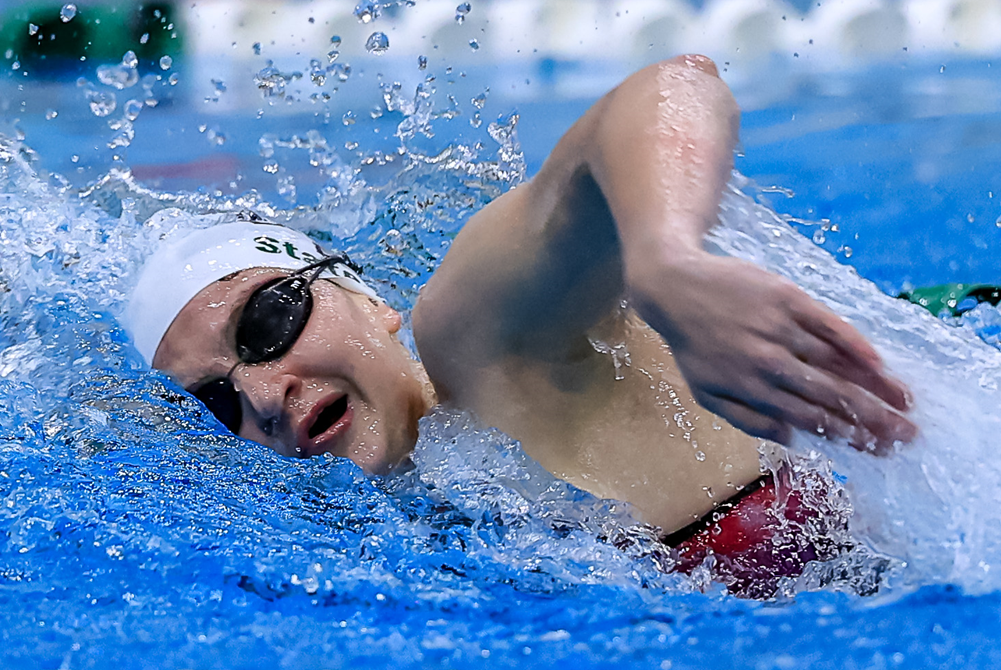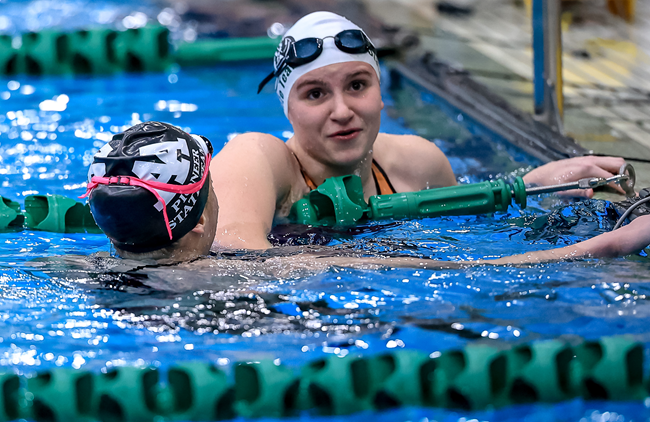
Be the Referee: Swim Finishing Touch
September 19, 2019
This week, MHSAA officials coordinator Sam Davis explains a new rule in swimming that allows for more flexibility when determining when a competitor has finished a race.
Be The Referee is a series of short messages designed to help educate people on the rules of different sports, to help them better understand the art of officiating, and to recruit officials.
Below is this week's segment - Swimming Finishing Touch - Listen
There’s a swimmer-friendly rules change being made in that sport this season. The definition of a legal finish has been changed to allow a competitor to touch any part of the finish end of the lane.
Previously, a swimmer had to contact the touch pad for a legal finish. The touch rule has also been changed to apply during relay races – where prior to this season only the final swimmer had to touch the finish end of the pool.
While the changes may provide some flexibility for swimmers, it does put additional responsibility on lane judges and back-up hand timers to be ready for those occurrences when a swimmer does not contact the touch pad.
Sept. 12: Curbing Gamesmanship By Substitution - Listen
Sept. 5: Football Safety Rules Changes - Listen
Aug. 29: 40-Second Play Clock - Listen

Eichbrecht Stacking Championships at Midpoint of West Bloomfield Career
By
Keith Dunlap
Special for MHSAA.com
November 28, 2023
WEST BLOOMFIELD — When she started high school swimming last fall, West Bloomfield sophomore Elizabeth Eichbrecht didn’t know what expectations to have, given she knew full well the high level of competition there was throughout the state.
 Well, after two seasons, it’s safe to say Eichbrecht has blown any expectations she had out of the water, pun intended.
Well, after two seasons, it’s safe to say Eichbrecht has blown any expectations she had out of the water, pun intended.
At the MHSAA Lower Peninsula Division 1 Finals on Nov. 17-18 at Eastern Michigan University, Eichbrecht won her third and fourth individual championships.
She won the 200-yard freestyle in a time of 1:48.08, more than three seconds ahead of the next finisher. The winning time qualified for All-America recognition and bested her first-place time from the 2022 Finals by 0.34 seconds.
Later on, Eichbrecht won the 500 freestyle in a time of 4:47.66, more than 11 seconds ahead of the rest of the field. Her All-American time in that event was more than five seconds better than her winning time in 2022.
Two years, four Finals titles. Not too shabby.
“Yes it’s surprising, because there are so many fast girls and we are all very competitive,” Eichbrecht said.
Eichbrecht already holds six school records – in all four freestyle events, the 200 individual medley and 100 butterfly.
 She also owns Oakland Activities Association records in the 200 and 500 freestyles and the 100 butterfly.
She also owns Oakland Activities Association records in the 200 and 500 freestyles and the 100 butterfly.
“I like the distance events more, mainly because I don’t have to all-out sprint,” Eichbrecht said.
West Bloomfield head coach Ronson Webster said the big reason why Eichbrecht was even better this year as a sophomore after making such an impact as a freshman wasn’t necessarily because she was bigger and stronger, although those were contributing factors.
Mainly, her success this year was the validation that she belonged after such a great freshman season.
“She gained more confidence this year going into her races,” he said. “She focused on racing her race and not who was next to her. Meeting the time we worked for was the goal. Winning is a bonus.”
While Eichbrecht excels at so many events, her specialty has been the 200 and 500 freestyles, which is stating the obvious given the Finals titles she has won in those events.
“Her training is very specific as it is for every swimmer on our team,” Webster said. “Everyone is trained differently. Her technique is very important and specific to her event and body size. Since she is shorter, she can’t swim the same as a tall person. Having the right technique designed for the swimmer and the correct race plan goes a long way.”
Eichbrecht next will focus on her club season for Supernova Swim Team based out of Farmington Hills, and she already is looking forward to competing at the Winter Junior Nationals in Columbus from Dec. 6-9.
By the time her career is over, it’s safe to say Eichbrecht might be the best all-time from a West Bloomfield school that’s not known as much for swimming as other Oakland County powers such as Farmington Hills Mercy or the Birmingham schools. But Eichbrecht is relishing putting her school on the swimming map with all her success so far.
“I love swimming at WB,” she said. “My teammates are amazing, and they work super hard. I’m super proud of all the work they put in this season, and I can’t wait for next season.”
 Keith Dunlap has served in Detroit-area sports media for more than two decades, including as a sportswriter at the Oakland Press from 2001-16 primarily covering high school sports but also college and professional teams. His bylines also have appeared in USA Today, the Washington Post, the Detroit Free Press, the Houston Chronicle and the Boston Globe. He served as the administrator for the Oakland Activities Association’s website from 2017-2020. Contact him at [email protected] with story ideas for Oakland, Macomb and Wayne counties
Keith Dunlap has served in Detroit-area sports media for more than two decades, including as a sportswriter at the Oakland Press from 2001-16 primarily covering high school sports but also college and professional teams. His bylines also have appeared in USA Today, the Washington Post, the Detroit Free Press, the Houston Chronicle and the Boston Globe. He served as the administrator for the Oakland Activities Association’s website from 2017-2020. Contact him at [email protected] with story ideas for Oakland, Macomb and Wayne counties
PHOTOS (Top) West Bloomfield’s Elizabeth Eichbrecht swims the winning 200-yard freestyle Nov. 18 at Eastern Michigan University. (Middle) Eichbrecht talks with runner-up Yan Yee Adler from Ann Arbor Pioneer after also winning the 500 freestyle. (Click for more from High School Sports Scene.)

